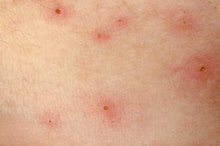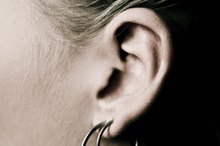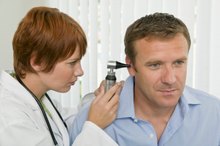Little Bumps on the Ears
Little bumps on the ears might cause frustration and pain, especially if the bumps interfere with wearing glasses or earrings. If the bumps grow in size or number, ooze, change in color, cause pain or persist, seek medical evaluation as little bumps on the ear sometimes are a sign of a serious medical condition. Fortunately, most cases of little bumps on the ears are preventable with lifestyle changes and treatable with medical care.
If you are experiencing serious medical symptoms, seek emergency treatment immediately.
Features
Little bumps on the ears often look like pimples, and might appear red or white in color. People with little bumps on the ears might develop additional symptoms, including redness and swelling around the bump, itchiness and pain, especially if the bumps are located near where eyeglasses or earrings fit on the ears. In some cases, the bumps might ooze pus or bleed, especially if scratched.
Identification
Why Do My Ears Feel Hot?
Learn More
You might notice little bumps on the ears when performing hygiene activities such as washing or applying cosmetics, or when putting on eyeglasses or earrings. Dermatologists or general practice physicians diagnose little bumps on the ears by conducting a physical exam and asking the patient about their medical history and recent activities such as swimming. If an infection is suspected, the doctor might collect a sample of fluid, pus or blood and send it to a laboratory for testing.
Causes
Many conditions affect the skin and outer ear that might cause:
- little bumps
- including acne
- actinic keratoses
- allergic contact dermatitis
- cellulitis
- chondrodermatitis nodularis helicis
- epidermoid cysts
In addition, basal cell carcinoma, squamous cell carcinoma and melanoma skin cancers might appear as little bumps on the ear, especially in people with light skin or with a history of significant sun exposure. Infections including abscesses and boils might cause little bumps on the ears, as can bites or stings from insects.
Treatments
White Bumps on the Top of My Ears
Learn More
Doctors treat infections of the outer ear and skin of the ear with oral or topical antibiotics, and might recommend pain relievers such as ibuprofen to relieve symptoms such as pain and swelling. Little bumps on the ear caused by skin conditions such as acne may also be treated with topical antibiotics. Treating epidermoid cysts requires medical treatments that might include injection of corticosteroids, incision and drainage or total excision of the cyst, notes MayoClinic.com 3.
Prevention/Solution
Using oil-free hair and skin products can help prevent little bumps on the ears that are caused by acne and epidermoid cysts. Avoiding prolonged exposure to the sun, using sunscreen on the face and ears and wearing a wide-brimmed hat while spending time outdoors might help prevent skin cancers and the development of epidermoid cysts. To avoid worsening the condition, don't pick or scratch at any of the bumps on the ears.
Related Articles
References
- SkinSight.com: Adult Ear Conditions
- FamilyDoctor.org: Ear Problems
- MayoClinic.com: Sebaceous Cysts
- "Actinic keratosis." MedlinePlus Medical Encyclopedia. U.S. National Library of Medicine, National Institutes of Health, 07 May 2017. Web. https://medlineplus.gov/ency/article/000827.htm
- "Milia." MedlinePlus Medical Encyclopedia. U.S National Library of Medicine. National Institutes of Health, 21 Apr 2015. Web. https://medlineplus.gov/ency/article/001367.htm
- "Seborrheic Keratoses." AAD.org. American Academy of Dermatology. Web.https://www.aad.org/public/diseases/bumps-and-growths/seborrheic-keratoses
- Avhad G, Ghate S, Dhurat R. Milia en plaque. Indian Dermatol Online J. 2014;5(4):550-1. doi:10.4103/2229-5178.142573
- Gold MH, Baldwin H, Lin T. Management of comedonal acne vulgaris with fixed-combination topical therapy. J Cosmet Dermatol. 2018;17(2):227-231. doi:10.1111/jocd.12497
- Tagliolatto S, Santos neto Ode O, Alchorne MM, Enokihara MY. Sebaceous hyperplasia: systemic treatment with isotretinoin. An Bras Dermatol. 2015;90(2):211-5. doi:10.1590/abd1806-4841.20153192
- Zuber TJ. Minimal excision technique for epidermoid (sebaceous) cysts. Am Fam Physician. 2002;65(7):1409-12, 1417-8, 1420.
- Wollina U. Seborrheic Keratoses - The Most Common Benign Skin Tumor of Humans. Clinical presentation and an update on pathogenesis and treatment options. Open Access Maced J Med Sci. 2018;6(11):2270-2275. doi:10.3889/oamjms.2018.460
- Dodds A, Chia A, Shumack S. Actinic keratosis: rationale and management. Dermatol Ther (Heidelb). 2014;4(1):11-31. doi:10.1007/s13555-014-0049-y
- Lanoue J, Goldenberg G. Basal Cell Carcinoma: A Comprehensive Review of Existing and Emerging Nonsurgical Therapies. J Clin Aesthet Dermatol. 2016;9(5):26-36.
- Nair PA, Singhal R. Xanthelasma palpebrarum - a brief review. Clin Cosmet Investig Dermatol. 2018;11:1-5. doi:10.2147/CCID.S130116
- "Actinic keratosis." MedlinePlus Medical Encyclopedia. U.S. National Library of Medicine, National Institutes of Health, 07 May 2017. Web.
- "Milia." MedlinePlus Medical Encyclopedia. U.S National Library of Medicine. National Institutes of Health, 21 Apr 2015. Web.
- "Seborrheic Keratoses." AAD.org. American Academy of Dermatology. Web.
- Zaenglein AL, Pathy AL, Schlosser BJ, Alikhan A, Baldwin HE, et. al. "Guidelines of Care for the Management of Acne Vulgaris." Journal of the American Academy of Dermatology. 2016; 74 (5):945-73.
Resources
Writer Bio
Jessica Lietz has been writing about health-related topics since 2009. She has several years of experience in genetics research, survey design, analysis and epidemiology, working on both infectious and chronic diseases. Lietz holds a Master of Public Health in epidemiology from The Ohio State University.









